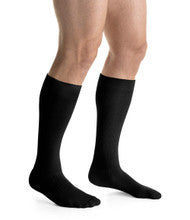If you’re the outdoorsy type, you know that there are few things more fun and exhilarating than a hike through nature. Whether you’re hiking up a mountain or just taking a low-stress walk through the woods, you want to enjoy yourself. Naturally, a very important part of the experience is making sure that you feel comfortable and have the physical support to see your adventure through to the end!
But if you’re new to hiking, you may not be aware of the benefits of compression socks. The fact is that compression hiking socks can be absolutely vital for some individuals, and for most hikers, they can provide a lot of extra support. But what exactly do hiking compression socks do? Is it comfortable to wear compression socks while hiking? Finally, where can you get high-quality compression socks to wear during your next hike?
In today’s guide, we’re going to answer all of these questions and more. So, let’s get started!
Why Compression Socks Are Good For Hiking
There are many benefits of compression socks that make them a great tool for hikers. Here are just a few of the advantages you can enjoy if you wear compression socks for long-distance walking and hiking:
- Improving Circulation - Even if you don’t hike regularly, wearing compression socks is a great way to really get the blood pumping in your feet, legs, and ankles. Not only does this reduce the risk of blood clots, but it generally helps promote healthy circulation. When hiking, this can also help reduce fatigue, swelling, and pain.
- Reducing Muscle Fatigue - Hiking puts a lot of strain on muscles, particularly the muscles in the lower half of your body. If you’re new to hiking or you’re planning a very challenging hike, you can anticipate a lot of muscle fatigue in your legs that might make it difficult to finish the hike. Thankfully, compression socks can help support the muscles in the calf, reducing fatigue and lowering the risk of painful muscle tears.
- Providing Joint Support - One of the most common injuries you will experience during a hike is a twisted or sore ankle. While most compression socks are not specifically designed to provide substantial joint support, they do help keep your ankles in their natural position, which decreases the risk of rolling, twisting, or otherwise hurting your ankle on a hike.
It’s a bit limiting just to talk about hiking though. Compression socks are great for a variety of physical activities and cardiovascular exercises. If you like doing any kind of “marathon” activity that involves your feet and legs, there’s a good chance that you could benefit from compression socks. This is part of the reason why so many athletes wear compression socks while training; they are a great form of athletic support, helping to prevent injuries and generally ensuring that runners and other athletes can perform at their best.
Wearing Compression Socks After Hiking
Compression socks aren’t just a good way to avoid injury and fatigue during a hike; they can also be extremely beneficial during your post-hike cool down or recovery. After a hike, your body, particularly the muscles in your legs, will be extremely tired. When you use muscles, they naturally tear and reform to become bigger and stronger. During this healing process, compression socks can help increase blood flow and ensure that your muscles get the oxygen they need to recover as quickly as possible. As a result, that pain you feel after a hike or intense workout will be much more manageable with the help of compression socks.
Increased circulation has a few other benefits, too. Compression socks increase blood flow, which helps flush out metabolic waste like lactic acid. This speeds up the post-hike recovery and reduces the severity of muscle soreness.
This doesn’t even factor in the link between compression socks and swelling (which is very important). After a hike, most people experience mild to moderate swelling of the feet, ankles, and/or legs. This is completely normal, but it’s not very comfortable. While this swelling is not normally a sign of a serious medical condition, you’ll still want to find ways to alleviate it. The pressure of compression socks helps reduce swelling and speed up recovery, which is beneficial even if you didn’t sustain any injuries during a hike.
Compression socks also provide a certain degree of structural support to your ankles and legs. It’s not uncommon to experience a rolled or sprained ankle while hiking through rough or uneven terrain. With compression socks, you have better support to keep your ankles from twisting or rotating into awkward positions. This reduces the risk of injury and generally helps you to feel more confident as you move!
The Best Compression Socks For Hiking
As you can see, there are plenty of reasons to consider hiking in compression socks. However, this doesn’t mean that compression socks are going to be the perfect fit for every single person or situation. If you plan to hike in hot weather, you may feel a bit overheated by wearing additional garments. Fortunately, thinner compression socks made with breathable materials like sheer nylon still give you the compression benefits without making you feel like you’re dressing for an Arctic excursion!
In any case, the best compression socks for hiking will generally be socks that feel light and comfortable, while also providing adequate pressure and support to your legs and ankles. Here are a few factors that you’ll want to consider:
- Material - The material is one of the most important factors when shopping for the right hiking compression socks. Most compression socks are made of nylon, polyester, spandex, or a combination of similarly expansive materials. These are strong enough to apply pressure without feeling overly heavy or hot. For hiking, it’s best to choose a lightweight material that will let your skin breathe, like nylon.
- Pressure - The degree of pressure is pivotal for getting compression socks that will be comfortable during a hike. For instance, lower compression socks (8 to 15 mmHg) will apply less pressure, but they will generally give you more freedom to move. Alternatively, if you need more support or pressure, then you might opt for a higher compression model (20 mmHg and above).
- Design - There are a wide variety of compression sock designs. Some have openings around the heel of the foot and the toes, which helps make them more breathable and less constricting. While this might sound perfect for hiking, you should also consider compression socks with extra padding around the heels and toes, as this can help prevent blisters.
- Size - You can find compression socks that only cover part of the foot, the entire foot, the foot and lower leg, or nearly every inch of your body below the upper thigh. The right size for hiking will generally be something that at least provides coverage up to the mid-calf, but you may find that a smaller or larger size is better suited to your needs.
- Durability - Unlike compression socks that you just wear around the house, compression socks for hiking are going to get a lot of wear and tear with each use. This means you’ll need to acquire your compression socks from a quality provider like Compression Health to ensure that you get durable, long-lasting compression garments!
We hope you found this guide on compression socks for hiking both useful and informative! Are you currently in the market for compression socks, sleeves, or other compression wear? If so, be sure to reach out to Compression Health today!




Share:
Compression Socks For Swelling
A Comprehensive Guide to Lymphedema